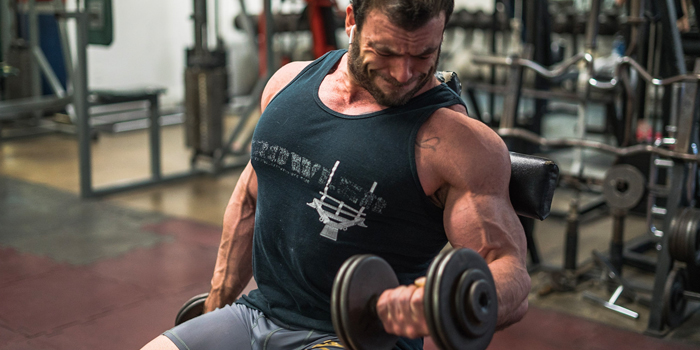
You guys probably know by now that the theme of the past year for me has been injury. I performed far below my own expectations at the Tribute meet last August due to a strained adductor and then dropped out of the U.S. Open this year due to crippling tendonitis.
Now, these injuries can’t be considered “unexpected” — I’ve been training and competing hard, without a break, for nearly six years at this point. Plus, I’m getting older. At 31, I still have plenty of time to continue competing, but I’m learning that I have to be more conservative about how I train, listen to my body more carefully, and spend more time on recovery and rehab to be able to do so.
So, in an effort to give my body the break it deserves, address my imbalances, and learn more about the application of strength in areas outside of powerlifting competitions, I’m now pursuing my pro card in classic bodybuilding. I’ve been working with the Grain Train guru John Meadows, and I’ve already learned a lot, much of which I plan to apply to my powerlifting training in the future. The rest of this article will share some of these methods so that you can benefit from my experiences, too.
A Longevity-Based Plan
The thing to keep in mind as you read the remainder of this program is that I’m describing a method of training — not a set-in-stone program. In other words, it’s up to you to apply the method to your particular context: your body, your goals, and your life situation. This is by far the most challenging aspect of any program design, and in the future, I’ll have more resources to help you do exactly that (and of course, you can always contact me via email for one-on-one help). For now, though, we’re just going to describe the skeleton of the method so that you have a solid foundation from which to plan.
Overview
At a high level, this method closely follows the Mountain Dog division of training and applies those divisions to powerlifting rather than bodybuilding. In case you’re not aware of them, the phases of a Mountain Dog Workout are:
- Warm-up and activation: “Priming” the mind-muscle connection, typically with some higher-volume, submaximal isolation movement
- Explosive strengthening: Typical powerlifting-style training applied to bodybuilding movements to strengthen connective tissue and build contractile tissue
- Supramax pump: Typical bodybuilding training intended to fill the muscle with blood and promote sarcoplasmic hypertrophy
- Loaded stretch: Training the muscle from a stretched position (in theory, at least) stretch the muscle fascia to stimulate growth
You’ll notice that all four phases are goal oriented — that is, they have a specific and unique purpose within the context of a single training session, but they’re all focused on getting bigger. My training is very much the same in this regard, except each phase is focused primarily on getting stronger and bigger, not just the latter.
Finally, note that any form of successful training requires overwhelming attention to recovery. Sufficient sleep, a healthy performance-based diet, and a low-stress lifestyle are essential to making this plan work for the long term.
With all that in mind, let’s check out the individual phases of a successful training session!
Phase 1: Warm-Up and Activation
While I’ve taken the name of this phase directly from the Mountain Dog manual, the content of the phase is drastically different. There won’t be any isolation movement here: we’re focused on creating the optimal environment for strengthening by warming up the entire body as a unit. That entails:
- Beginning with a general cardiovascular warm-up. This is typically three to five minutes of a low-impact activity like stationary cycling, walking, or even sled dragging, although you may require a bit longer if you’re an older lifter (past 40) or in a cold environment. Your metric here is body temperature. You want to raise your core body temp by a degree or two, which essentially means breaking a very light sweat.
- Mobilize joints and connective tissue. This refers to your standard mobility work, with a focus on known issues. For example, my right shoulder is always giving me a little trouble; for any training session involving the competition lifts, I’ll begin with some shoulder swings using a resistance band for distraction. You can include any sort of mobility work here, including CARs, dynamic stretching, and the like, but try to limit yourself again to about three to five minutes of work. We don’t want to expend too much energy in this phase.
- Activation movements. While most people will jump straight from their warm-up to their first exercise of the day, I think it’s very helpful to prepare the muscles involved in that exercise with a sort of transition (remember, we already addressed the joints in Step 2). Here’s where you can add in plyometrics, bodybuilding techniques like the one shown below, or even some very light isolation work (preferably with bands for resistance).
Taken as a whole, this phase should last about 10 to 15 minutes and consist entirely of low-intensity movement with light resistance. It is designed to prepare the body and mind for vigorous activity and therefore is not progressive. In other words, don’t try to do more at every session: You’re shooting for “just enough” to set yourself up for success in the next phase.
If you don’t have go-to movements for your warmup and activation phase, I highly suggest you check out these resources:
Also, make sure to check out the Kabuki Strength movement library — a fantastic resource from Chris Duffin (but admittedly with a subscription fee).
Phase 2: Competition Training
This phase is designed to improve your competition lifts. It doesn’t really matter what you’re training for — powerlifting, strongman, Olympic weightlifting — this phase is where you’ll perform the meat and potatoes of your training.
There are many different ways to structure this phase. My personal favorite is a waved progression of volume and intensity, set up like this:
- Week 1: 3-5 sets of 5 at 74-79% 1RM
- Week 2: 4-6 sets of 2 at 85-92% 1RM
- Week 3: Work up to a top set of 3 with your Week 2 weight
- Weeks 4-6: Repeat weeks 1-3 with slightly more weight
You can check out my Think Strong ebook for more detail on this sort of waved loading for both offseason and contest prep, but of course, that’s not the only “right” method of progression. If you prefer the Westside method, simply plug in your ME or DE training here. If you use RPEs, no problem: This phase will consist entirely of competition lifts or close variations, programmed with whatever RPE, set, and rep scheme you prefer. Same for linear or periodized percentage-based styles — everything works; the key is to find what works for you.
The key here is to progress. I’d prefer you keep effort high regardless of your volume and intensity balance, but if you’re pushing so hard that you can’t add weight to the bar over time (not necessarily every training session), then you need to back off. If you can progress, though, then, in my opinion, there are a lot of benefits to training as hard as possible. For example, learning to grind is a skill that needs to be practiced for when you’re busting out a true 1RM attempt.
Here are some methods to consider for increasing effort:
- Using accommodating resistance such as bands and chains
- Minimizing rest time between sets
- Incorporating load drops or backoff sets (not drop sets!)
- Occasional use of pre-workout stimulants
Again, there’s an enormous amount of information out there on how to program this phase in detail. Some of my favorites include my own Unf*ck Your Program course and series on YouTube.
And be sure to check out other resources here on elitefts, like this huge compendium of articles about the maximal effort method.
Wrapping Up
Hopefully, this at least gets you started on the path to forming your own longevity plan. The key takeaways from Part 1:
- Injuries will derail your progress as an athlete more than anything else. You should do everything in your power to prevent them, while still training like a hard motherf*cker.
- Paying careful attention to your warm-up is possibly the best way to prevent freak injuries, so follow the guidelines laid out above before every training session.
- Once your body is prepared for lifting, there are many different strategies to get strong(er). Find what works for you — don’t get sucked into believing anyone has all the right answers.
In Part 2, we’ll discuss Phases 3 and 4, which will address weak points and corrective exercise to further increase your strength and prevent injuries arising due to imbalances. Until then, remember to always Think Strong and Train Hard!











1 Comment